User Manual of VERS Wireless Touch Probe
Specifications

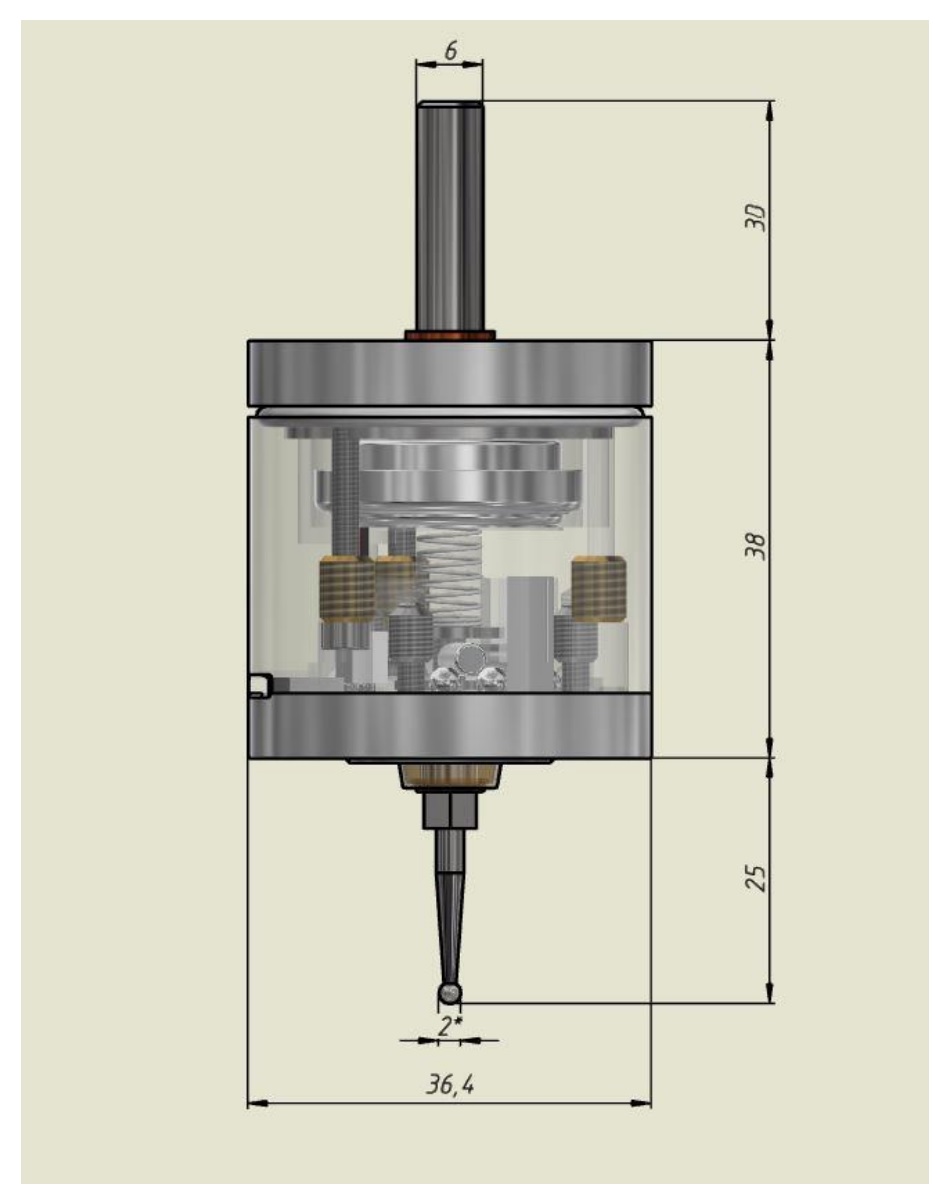
Features:
- the ability to connect the receiver to power sources in a wide range of +5V … +24V at the input andat the output,
- the ability to select different schemes of connection to the CNC controller: NPN-PNP, NC-NO,
- hardware implemented ability to integrate with npn-nc toolsetter on one common output and work independently,
- automatic selection of the most unloaded frequency sub-band 2.4 GHz,
- the ability to set sleep modes,
- the ability to correct signal delays thanks to a separately outputted error signal.
- ultra-low current consumption by the probe, 0.6 ma when realizing continuous radio communication, 0.06 ma in sleep mode, 0 ma when the power button is off,
- power supply of the sensor from the LIR2477 3.6v battery with possibility of charging, applied increasing the voltage on the contact group up to + 16v for sure closing of contacts,
- the frequency of recharging with daily use is on average 1-2 times a month, the charging time is 2 hours. You can continue to use the sensor when charging from the receiver, charging is also possible from any 5 volt chargers and from the computer USB port.
- when a cable is connected to receiver for charging, the sensor begins to transmit a trip signal on this cable, which can be useful in some cases (for example, with powerful radio interference),
- LED and buzzer indication of stylus pressing, radio signal level, battery charge level, error signal.
About radio channel:
- the delay in the radio channel is 0.75 milliseconds, in the entire chain from the ball contacts of the sensor to the output signal of the receiver is 1.5 milliseconds,
- provides a normally-closed connection of the probe to the receiver (continuous radio communication),
- the reliability of a normally closed loop via a radio channel is provided by a protocol with acknowledgment of reception and duplication of unconfirmed data,
- the delay of the programmed (for triple absence of acknowledgment) response of the receiver to the break of communication over the radio channel is less than 0.3 s, which provides a safe search at speed up to 1000 mm/min,
- ultra low consumption, power supply of the transceiver from one LIR2477 3.6 volt battery, current consumption in the wake-up mode of the probe (averaged) 0.6mA,
- Sleep mode 1. When the probe is not in use, automatic transition to Sleep mode after a userselected time interval (switch “Time to sleep” on the receiver, see below). Shaking or rotating in the spindle from 200 rpm wakes up the probe. Another way to enter Sleep Mode 1 is to hold pressed the stylus for 10 seconds. Current consumption in Sleep mode 1 – 0.06 mA. Sleep mode 2. When the receiver is turned off (for example, together with turning off the machine), the probe automatically switches to Sleep mode 2. A short automatic wakeup to search for a newly connected receiver will occur every 15 seconds. If before turning off the receiver the probe was already in Sleep mode 1, then it will remain in it. Current consumption in Sleep mode 2 – 0.07 mA. Before turning off the receiver, make sure that the stylus is not pressed (the red LEDs on the probe is not lit), the probe will not go to sleep when the stylus is pressed.
Connection
![]() The Probe consists of 2 parts: a touch probe and a receiver. To start, you first need to turn on the receiver, then the probe.
The Probe consists of 2 parts: a touch probe and a receiver. To start, you first need to turn on the receiver, then the probe.
![]() To charge the battery, turn OFF the probe and receiver, connect them with the supplied USB cable, turn ON the receiver, than probe. The probe can be used for measurements. Also , instead of the receiver, you can use any 5 volt DC source with a USB port for charging, as well as a computer USB port.
To charge the battery, turn OFF the probe and receiver, connect them with the supplied USB cable, turn ON the receiver, than probe. The probe can be used for measurements. Also , instead of the receiver, you can use any 5 volt DC source with a USB port for charging, as well as a computer USB port.
Functions of switches and pinout of the receiver connector.

«Time before sleep»: specifies the interval of inactivity of the probe, through which the probe will automatically enter sleep mode. Exit from that sleep mode – by hold down the stylus 5 seconds. There is an important difference in the receiver’s operation, depending on whether “Time to Sleep” is set or off (in the state of the switches 00). If the “Time to Sleep” is not set, turning off the probe or breaking the radio has the same effect as pressing the stylus – the output signal appears on the OUT of the receiver. If the “Time to Sleep” is set, turning off the probe, or going it into sleep, or breaking the radio does not affect the OUT output, but initiates the ERR output. This allows you to continue to use the second connected TS sensor. When “Time to Sleep” is set, it is recommended either to press the stylus for waking 5 seconds or to test the ERR signal before each measurement and 5 seconds to press the stylus only if there is an ERR signal.
Output “ERR”: The Error signal is a detector of excessive (greater than 1.7 milliseconds) delays. Accompanied by LED indication in the receiver. Provides the ability to cancel an incorrect measurement in the event of a delay in the response of the radio channel. The delay occurs when a short acknowledgment packet was still sent at the moment the stylus was pressed, the delay can be up to 12ms. The probability of such an event, depending on the period of acknowledgment packets specified by the user ( pool period ): 0.3s – 3.6%, 1s -1.2%, 3s – 0.4%. The software check of the Error signal is set immediately after the search for G38 (linuxcnc), G31(mach3), before releasing the stylus, if an Error signal is detected, it is recommended to perform the measurement again. Alternatively, you can not use ERR, then, to be completely sure of the measurement, measure one place twice and accept if both measurements coincide with the required accuracy. Also, if you make a latch measurement at a speed of <10mm/min, the error from the maximum possible delay will be <0.002mm, in some cases this may be sufficient. Also, ERR is used to determine the need to wake up the probe from Sleep mode 1. Then to wake up: in manual mode – shaking, in automatic mode – software check of the Error signal is performed before searching G38 (linuxcnc), G31(mach3), in case of detection of the Error signal ERR it is necessary to rotate probe in the spindle 200 – 1500 rpm. To work with the Err signal, it is necessary that your cnc controller has 1 free input pin. ERR out should be considered as a separate sensor that connects to this input pin.
For LinuxCNC users:
The Optional Interpreter feature needs to be turned-on.
http://linuxcnc.org/docs/2.7/html/remap/remap.html#_optional_interpreter_features_ini_file_configuration
[RS274NGC]
FEATURES = 30
In the configuration .hal file, this input is assigned a digital pin: net signal-name motion.digital-in-00 <= parport.0.pin10-in
The state of the digital input is read in the right place of the g-code program using the command
M66, http://linuxcnc.org/docs/html/gcode/m-code.html#mcode:m66M66 P0 L0
The current value of the input is stored in parameter #5399″, For check it (DEBUG, #5399) o100 if [#5399 EQ 1]
“Buzzer“: activates the sound signal by pressing the stylus.
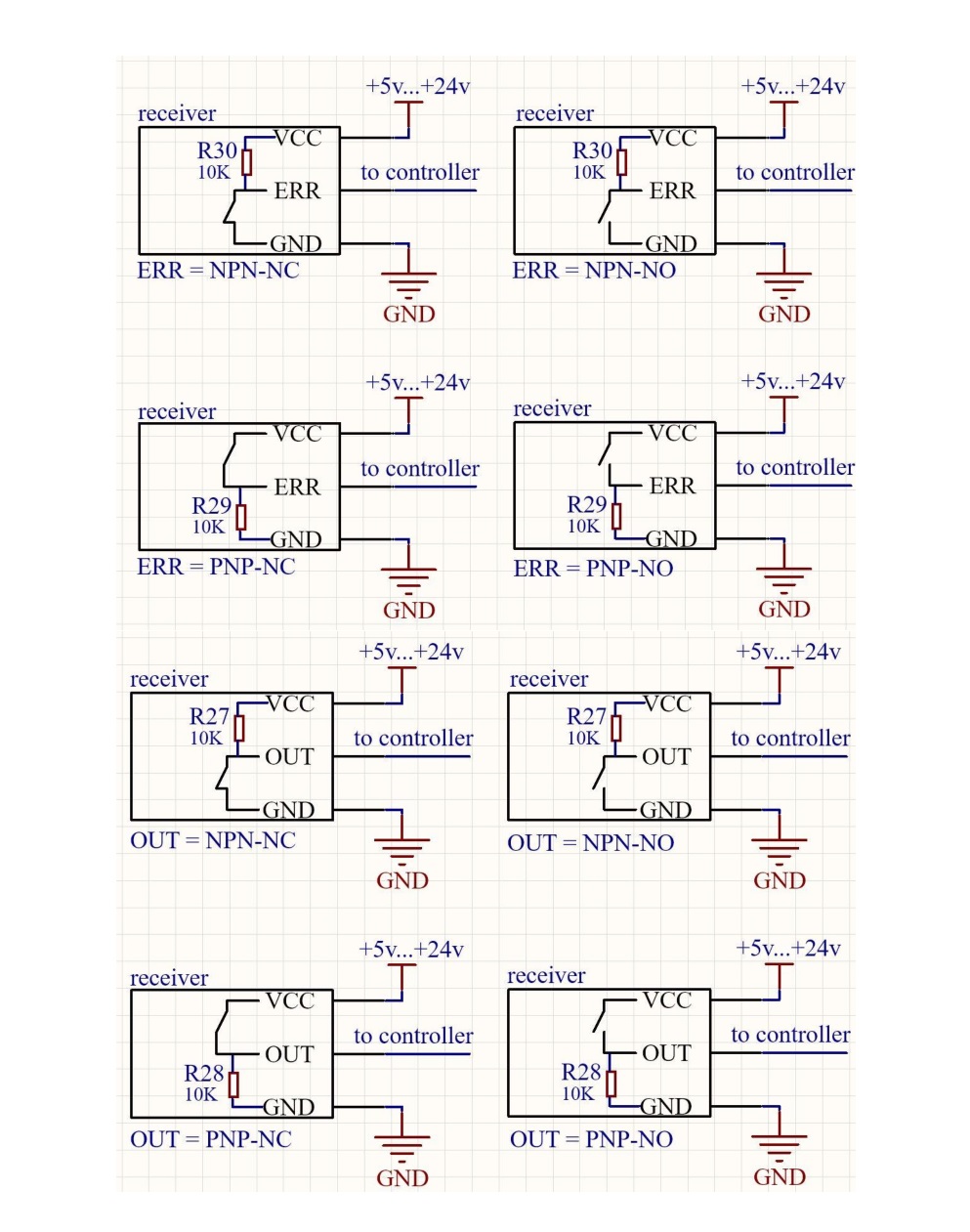
Input “TS”: is used to connect the tool setter TSm or WTSm (or other third-party NPN-NC or NC type sensors) to the receiver to one common “OUT” output in the OR logic, which allows any of the sensors to be switched off independently (for example, if WLR “gone into a sleep”, TSm will remain in working order). The TSm connects to the WLR as shown in the diagram below and in this case uses the WLR power supply. TSm can also use its own power supply.
“ERISE” (“SERV”) button: when the receiver is switched on and that button is pressed simultaneously, one of two service procedures is performed:
- “Binding probe to receiver” if the probe is connected to the receiver with a USB cable.
- “Storing TS status” if the probe is not connected to the receiver with a USB cable.
Binding probe to receiver:
The devices are shipped with the binding procedure already completed. This procedure is only needed to bind the receiver and probe from different kits.
- Turn off the receiver, probe, and all wireless devices in the same room.
- Connect the receiver and probe with a USB cable.
- Erasing flash-memory: while holding down the “ERISE” button, turn on ONLY the receiver, while the probe must be OFF, release the “erase” button, 4 short beeps will notify you of the successful erasing of the memory. Turn off the receiver. Disconnect the USB cable. The memory was cleared both in the receiver and in the probe.
- Writing information about the new partner to the flash memory: turn on the receiver, 5 short beeps will notify that the memory has been erased. Turn on the probe. The receiver and the probe communicate wirelessly, automatically exchange and store information about the partner in flash memory when you first turn it on.
Storing TS status:
The devices are shipped with the procedure already completed, the status “no TS” is saved in the flash memory, i.e. there must be no connection at the “TS” input of the receiver. Another possible status is “TS connected”, ie. a tool setter is connected to the “TS” receiver input.
This procedure needs to be performed once when tool setter physically connects to (or disconnects from) receiver.
- Turn off the receiver, disconnect the USB cable from the receiver, nothing should be connected to the “TS” input, even if the “TS connected” status is needed there.
- Set DIP switch #6 “TS simulate” to desired position: i.e. 1 (ON) – “no TS”, the tool setter will not be physically connected, it will be simulated; 0 (OFF) – “TS connected”, the tool setter will be physicallyconnected.
- With the “ERISE” button pressed, turn on the receiver, 2 short beeps will notify that the “no TS” status has been stored in the memory, 3 short beeps – the “TS connected” status has been stored in the memory. Turn off the receiver.
- If the status “TS connected” has been selected, the tool setter must be physically connected.
Probe LED indication:
- red LED is ON: stylus pressed;
- green LED 1 short ON pulse: stylus released;
- the green LED is constantly lit or switches 2 times per second: the link with the receiver is broken, it is necessary to restart (off-on) the receiver, and then the probe.
- the blue LED is on: the battery is charging, with a strong battery discharge the blue LED may not turn on immediately while the dynamic control system restores the charge to a safe minimum level.
Receiver LED indication:
- combination of active red LEDs immediately after turning on the receiver: the number of the clearest subband;
- red LEDs are ON: stylus pressed, active LED quantity corresponds to level of transmitted radio signal;
- green LEDs are ON: stylus released, active LED quantity corresponds to the battery charge level;
- blue LED ON: radio link error, ERR output status indication.
Adjustment
It is necessary to adjust the probe before starting the measurement. The probe is installed in the spindle, a check indicator is placed near to it (Fig. 1)
The indicator should be sensitive to a weak effect of 0.3-0.5N (for example, most lever indicators have this property).
The axis of the spindle is rotated by hand and the amplitude of the deflection of the stylus ball from the axis of rotation is controlled by the indicator.
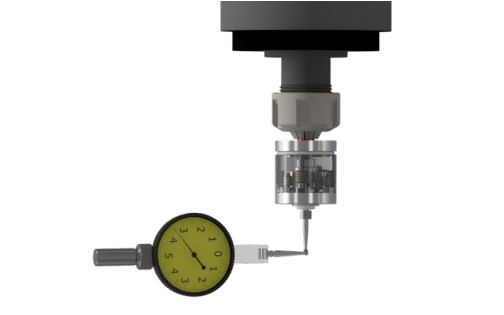
Fig.1
The deviation is eliminated by turning the adjusting screws M2.5 (the screws are recessed into the holes indicated by the green arrows in Fig. 2) with a 2mm hex key from the kit. When adjusting, both tightening and loosening of the screws are used.
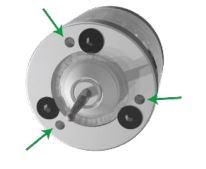
Fig.2
It is recommended to hold for a short lever of the key , so as not to develop excessive force (Fig. 3). It will be necessary to perform several cycles of spindle axis rotation–control– adjustment in order to achieve a minimum deviation acceptable for a particular measurement.

Using
The radio channel in the Probe supports continuous radio communication, thereby simulating a normally-closed loop of transmitter-receiver interconnect. A broken radio link is identical to a broken wire, with the only difference being that on the receiver side, which is directly connected to the machine, the response to a broken link, a signal at the OUT or ERR outputs, comes with a delay of 0 to 0.33 seconds (do not confuse with a delayed response to pressing stylus ~ 2ms). This is a deliberate compromise to save battery in the Probe. The graph below shows the speed-acceleration combinations that are safe for searching (area with green hatching), at which the machine will stop exactly in time without breaking the stylus, even in case of an emergency radio link failure at the most “unsuccessful” moment when the stylus touches the part.
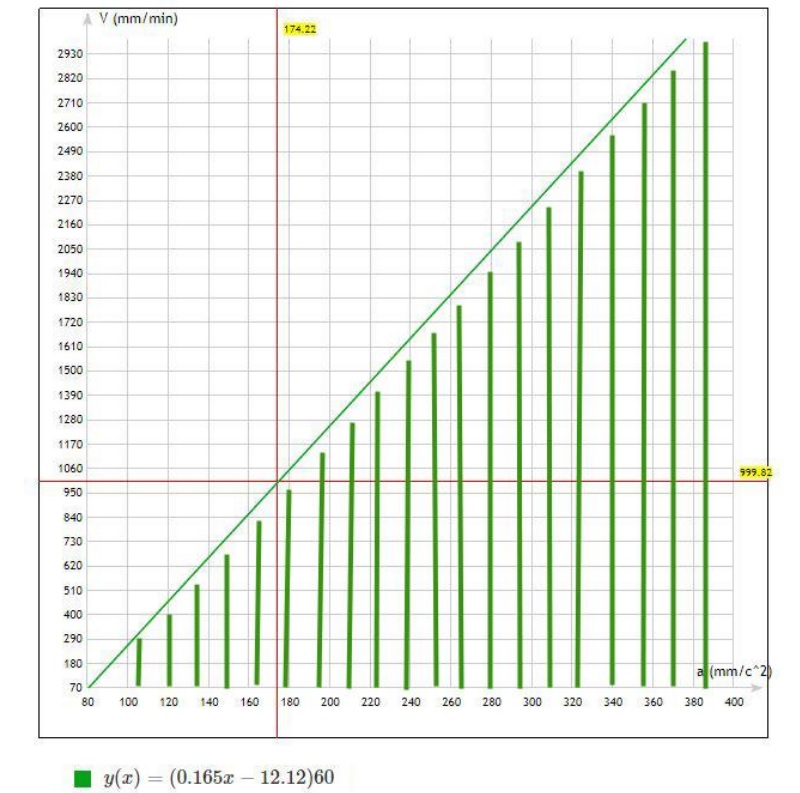
Formula is derived from initial conditions:
S = 4 mm permitted deviation stylus
t = 0.33c maximum delay time for detecting a communication break and then let it be the same (for example) to slow down and stop completely.
V – search speed in mm/min, Y axis on the graph
a – acceleration specified in the machine settings, in mm/c ^ 2, X axis on the graph (Formula used: S = -V * t + a * (t ^ 2) / 2 is the distance to move from initial velocity V to zero with acceleration a in time t)
